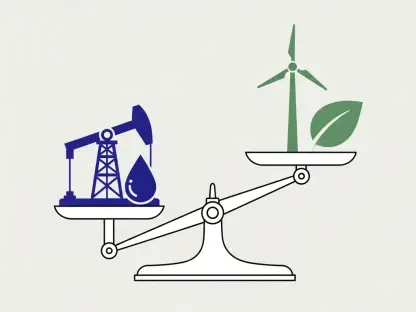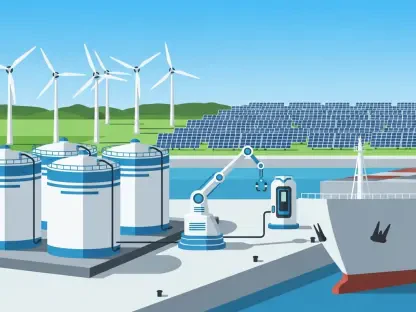As the digital age progresses, the environmental impact of traditional IT infrastructure has become a pressing concern. With businesses and individuals increasingly relying on digital data storage and processing, the need for sustainable solutions is more critical than ever. Cloud computing emerges as a powerful tool to address these challenges, offering multiple avenues to optimize energy usage and decrease emissions.
The Environmental Impact of Traditional IT Infrastructure
High Electricity Consumption and Greenhouse Gas Emissions
Traditional data centers, which businesses relied on before the advent of cloud computing, are notorious for their high electricity consumption. These on-premises facilities require substantial energy for continuous cooling, hardware maintenance, and operational purposes, leading to a significant output of greenhouse gases. As servers operate continuously, the demand on electrical grids surges, often leading to the burning of fossil fuels, which contributes to air pollution and global warming. Additionally, maintaining a controlled environment for server operations necessitates constant use of energy-intensive cooling systems, further escalating greenhouse gas emissions.
The reliance on non-renewable energy sources in powering these data centers amplifies their carbon footprint. Furthermore, the space and resources required to house these facilities mean a significant land use change, often encroaching on natural habitats and adding to environmental degradation. Transitioning from such high-consumption models to more energy-efficient alternatives is essential in curbing these negative impacts and fostering a sustainable approach to digital data management.
Inefficiency and Environmental Issues
The inefficiency inherent in traditional IT setups not only leads to higher operational costs but also exacerbates environmental issues. The fragmented nature of on-premises setups means that servers often operate below full capacity, leading to energy waste. Additionally, individual organizations lack the scale and resources to employ cutting-edge energy optimization and cooling technologies widely used by large cloud providers. This inefficiency results in unnecessary energy consumption and higher levels of greenhouse gas emissions, thus worsening the environmental impact.
The environmental issues extend beyond just energy consumption. Physical hardware in traditional setups has a shorter lifespan due to the lack of centralized management and optimization, leading to a high turnover rate for IT equipment. This turnover contributes to substantial amounts of electronic waste, which poses significant disposal and recycling challenges. Often, these electronic components end up in landfills, where they can leach toxic substances into the environment. Adopting more sustainable data management practices is therefore critical for both reducing waste and mitigating broader ecological impacts.
How Cloud Computing Promotes Sustainability
Energy Efficiency in Modern Data Centers
Cloud computing mitigates many environmental concerns through energy-efficient data centers operated by large cloud providers like Amazon Web Services (AWS), Microsoft Azure, and Google Cloud. These providers have invested in advanced cooling systems, AI-driven energy optimization, and renewable energy sources to minimize electricity consumption. Modern data centers are designed to operate at peak efficiency, utilizing techniques such as free-air cooling, which reduces reliance on traditional air conditioning by using external air to cool the servers.
AI and machine learning algorithms further enhance energy efficiency. These technologies enable dynamic resource allocation based on real-time demand, ensuring that servers are only fully operational when required. This reduces both energy waste and operational costs. Additionally, these data centers increasingly draw power from renewable sources like solar, wind, and hydroelectric power to diminish their carbon footprint. By combining technological innovation with green energy sources, cloud providers are setting new standards for sustainable data management.
Reduced Hardware Waste and Resource Optimization
Cloud computing minimizes the need for physical servers, thus reducing electronic waste. Traditional data centers typically have a high turnover of equipment as organizations continuously upgrade to meet evolving technological needs. In contrast, cloud providers manage infrastructure updates and maintenance centrally, significantly extending the life cycle of their hardware. This centralized management also reduces duplication of resources, as multiple organizations share the same underlying infrastructure without needing their own dedicated servers.
The scalability of cloud computing further enhances resource optimization. Businesses can adjust their capacity based on actual demand, avoiding the inefficiencies of under-utilized servers common in traditional IT setups. This dynamic adjustment not only optimizes energy use but also reduces the total number of physical servers required globally. As a result, the overall electronic waste associated with IT infrastructure is substantially reduced. Moreover, cloud providers often implement stringent e-waste recycling programs to ensure that when equipment does reach the end of its life cycle, it is disposed of in an environmentally responsible manner.
Innovation in Cloud Computing for Sustainability
Green Data Centers and Renewable Energy
Cloud providers are continually developing technologies to further their energy efficiency and sustainability missions. Green data centers, powered by renewable energy sources like solar, wind, and hydroelectric power, use energy-efficient hardware and smart technologies to minimize power consumption. These data centers are often strategically located in areas that maximize the availability of renewable resources, ensuring a steady supply of clean energy. In addition, green data centers incorporate cutting-edge energy management systems that monitor and optimize power usage in real time.
The hardware used in these facilities is selected and configured for maximum energy efficiency. For instance, low-power processors, solid-state drives (SSDs), and energy-efficient cooling systems contribute to reduced energy consumption. Moreover, data centers are designed to be modular, allowing for incremental expansion without significant increases in energy use. By leveraging renewable energy sources and advanced hardware, green data centers set a benchmark for sustainable data storage and processing solutions.
AI and Machine Learning for Energy Optimization
AI and machine learning algorithms play a crucial role in optimizing power usage. These technologies analyze energy consumption patterns, predict future demand, and adjust resource allocation dynamically to improve efficiency. By constantly monitoring performance metrics, AI systems can identify opportunities for energy savings that human operators might not detect. For instance, AI can optimize server workloads to ensure that all computing resources are fully utilized, thus avoiding the energy waste associated with idle servers.
Machine learning algorithms also anticipate peak demand periods and adjust cooling systems accordingly, ensuring optimal temperature management with minimal energy use. These algorithms can also proactively identify hardware that is likely to fail, enabling preemptive replacements and reducing downtime. Furthermore, AI-driven systems can facilitate smoother transitions to renewable energy sources by predicting periods of low and high energy production. This seamless integration of AI and machine learning in managing energy consumption positions cloud data centers at the forefront of sustainable technology.
Cloud Computing and Corporate Sustainability Goals
Carbon Neutral Commitments and Sustainable Practices
With sustainability becoming an increasingly critical focus for organizations worldwide, businesses are integrating cloud computing into their corporate sustainability strategies. Major cloud providers have committed to achieving carbon neutrality, with Microsoft pledging to be carbon-negative by 2030 and Google Cloud aiming to run entirely on carbon-free energy by the same year. These commitments have catalyzed a broader industry shift towards greener practices, encouraging enterprises to reconsider their own environmental impact.
By adopting cloud computing, companies can significantly curtail their carbon footprints and align with global sustainability goals. Cloud computing facilitates the implementation of energy-efficient practices and the use of renewable energy, positioning businesses as responsible environmental stewards. Additionally, cloud-based solutions enable companies to reduce reliance on physical infrastructure, thereby minimizing resources and energy consumption. Consequently, integrating cloud computing into corporate strategies can yield substantial environmental benefits while enhancing operational efficiency.
Cloud-Based Sustainability Analytics
Cloud platforms enable businesses to track their carbon footprint in real-time, providing insights into energy consumption, emissions, and resource efficiency. This capability facilitates data-driven sustainability improvements, helping organizations align with global climate initiatives. Using advanced analytics tools, businesses can gain a comprehensive understanding of their environmental impact and identify areas for enhancement. These platforms offer detailed metrics and visualizations, empowering decision-makers to implement targeted sustainability measures.
Moreover, cloud-based analytics tools can aggregate data from multiple sources, providing a holistic view of an organization’s sustainability performance. This integrated approach enables businesses to benchmark their progress, report to stakeholders, and ensure compliance with environmental regulations. By leveraging cloud computing for sustainability analytics, enterprises can make informed decisions that drive continuous improvement, enhance transparency, and bolster their reputation as environmentally responsible entities.
Challenges and Considerations
Data Center Energy Consumption and E-Waste Management
Despite its sustainability benefits, certain challenges accompany cloud computing. While more efficient than traditional data centers, cloud computing facilities still require significant energy. Ensuring these data centers utilize renewable energy sources is essential. Additionally, robust recycling and disposal strategies for outdated equipment are necessary to minimize environmental harm. Cloud providers must continuously invest in renewable energy projects and explore innovative solutions to further diminish their energy footprint.
E-waste management presents another critical challenge. The rapid pace of technological advancement results in frequent hardware upgrades, necessitating effective recycling and disposal mechanisms. Cloud providers must adopt sustainable practices in handling e-waste, including recycling components, repurposing outdated equipment, and ensuring environmentally friendly disposal methods. By addressing energy consumption and e-waste management, cloud providers can maximize the sustainability benefits of their services and mitigate potential environmental drawbacks.
Data Privacy and Security
As businesses migrate to the cloud, maintaining data security and compliance becomes paramount. Effective cybersecurity measures are essential to ensure that cloud solutions stay both sustainable and secure. The centralized nature of cloud data centers makes them attractive targets for cyberattacks, necessitating robust security protocols to safeguard sensitive information. Cloud providers must implement multi-layered security measures, including encryption, access controls, and continuous monitoring, to counter potential threats.
Compliance with data protection regulations further complicates cloud migration efforts. Businesses must ensure that their cloud services adhere to legal requirements, such as the General Data Protection Regulation (GDPR) and the California Consumer Privacy Act (CCPA). Achieving compliance requires collaboration between cloud providers and their clients to develop policies and procedures that protect against data breaches and unauthorized access. By prioritizing security and compliance, cloud computing can deliver sustainable solutions that also guarantee data integrity and privacy.
Future of Sustainable Cloud Computing
Quantum Computing and Edge Computing
The continuous innovation in cloud computing is critical for further advancements in sustainability. Emerging trends like quantum computing have the potential to revolutionize cloud computing by solving complex problems with minimal energy use. Quantum computers can perform calculations exponentially faster than traditional ones, resulting in significant energy savings. Their ability to tackle intricate simulations and optimizations could pave the way for greener technologies and more efficient data processing methods.
Similarly, edge computing reduces the need for data transmission to centralized data centers, decreasing energy consumption and latency. By processing data closer to where it is generated, edge computing minimizes the energy costs associated with long-distance data transfer. This is particularly beneficial for applications requiring real-time data analysis, such as autonomous vehicles and smart cities. Implementing edge computing strategies can enhance energy efficiency and support sustainable data management practices.
AI-Driven Sustainability Solutions
AI will continue to optimize energy consumption, resource allocation, and carbon tracking in cloud environments. These advancements will help organizations minimize their environmental impact and further drive sustainability in the digital age. AI tools can predict future resource needs, streamline operations, and ensure that energy usage is consistently efficient. Furthermore, AI-enabled systems can provide real-time insights into an organization’s carbon footprint, allowing for immediate adjustments and continuous improvement.
By integrating AI-driven sustainability solutions, cloud providers and their clients can harness the full potential of technology to achieve environmental goals. These innovations promise to make cloud computing an even more powerful tool in the fight against climate change, paving the way for a greener, more sustainable future.
Conclusion
As we advance in the digital age, the environmental impact of traditional IT infrastructure has become a significant issue. Businesses and individuals are increasingly dependent on digital data storage and processing, making the quest for sustainable solutions more vital than ever. Cloud computing has emerged as a compelling method to tackle these challenges. By shifting data and applications from on-premises servers, which consume high energy and emit significant carbon, to cloud-based platforms, we can optimize energy usage and reduce emissions. Cloud providers often use energy-efficient data centers with cutting-edge cooling technologies and renewable energy sources. This not only conserves power but also minimizes the carbon footprint. Moreover, the scalability and efficiency of cloud computing allow for better resource management. Therefore, adopting cloud computing presents a viable path toward a more sustainable and eco-friendly digital future.









